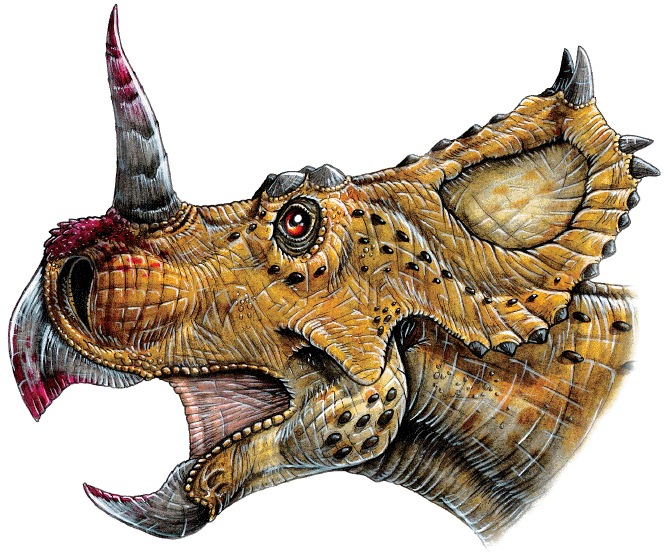|
Centrosaurus apertus
(Lambe, 1904) |
|
 |
|
Name Means: |
"Pointed Lizard" |
Length: |
20 feet (6 m) |
|
Pronounced: |
Sen-tro-Sore-us |
Weight: |
15 tons (13,600 kilos) |
|
When it lived: |
Late Cretaceous - 75 MYA |
|
|
|
Where found: |
Alberta, Canada |
|
|
|
Another ferocious looking horned dinosaur; Centrosaurus was
large and heavily built. With a big curved nasal horn and sharply
hooked spikes on its neck frill, an assault by Centrosaurus
would likely have resulted in giant stabbing and tearing wounds that
could be deadly to any opponent. It appears that Centrosaurus
traveled in large herds, both an invitation and a daunting sight to
the Cretaceous predators.
Centrosaurus was a fairly typical Ceratopsian family member,
with a heavy, stocky body, facial horns, and a neck frill with spikes.
The neck frill on Centrosaurus was rather small, but it had two
wickedly hooked spikes that curved sharply downward to hold and tear
the flesh of taller opponents. The brow horns were mere lumps, and the
nasal horn was long and slightly curved like a modern Rhinoceros.
Centrosaurus remains are part of one of the largest bone
beds ever located, in western Canada. Over 200 Centrosaurus
individuals have been identified, and most of the bone bed has yet to
be uncovered. Only a few juveniles have been located. This may mean
that predators followed the herds, waiting to attack the young and
weak.
The remains of Centrosaurus were first noted in Alberta by
palaeontologist Lawrence Lambe in 1904. Even today, most of the known
remains come from the badlands of the Red Deer River. The skull
alone was more than one meter (three ft) long, with a single forward
thrust nasal horn and small growths over each eye. Bony growths
decorated the edge of its frill, and protective tongues of bone
drooped over the two large frill openings. Some specimens have been
discovered with skin impressions. Like Chasmosaurus, the frill
was not solid bone; two large openings on either side reduced the
weight considerably, and provided edges for powerful jaw muscles to be
attached. Centrosaurus may have lived in herds for protection
from predators such as Albertosaurus. |
|
|
|
|
|
|
|
|
Edugraphics.Net | Feenixx Publishing |
|
|
|
|